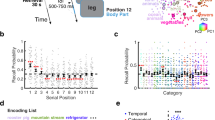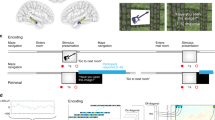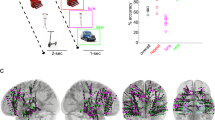Abstract
The medial temporal lobes, prefrontal cortex and parts of parietal cortex form the neural underpinnings of episodic memory, which includes remembering both where and when an event occurred. However, the manner in which these three regions interact during retrieval of spatial and temporal context remains untested. We employed simultaneous electrocorticographical recordings across multilobular regions in patients undergoing seizure monitoring while they retrieved spatial and temporal context associated with an episode, and we used phase synchronization as a measure of network connectivity. Successful memory retrieval was characterized by greater global connectivity compared with incorrect retrieval, with the medial temporal lobe acting as a hub for these interactions. Spatial versus temporal context retrieval resulted in prominent differences in both the spectral and temporal patterns of network interactions. These results emphasize dynamic network interactions as being central to episodic memory retrieval, providing insight into how multiple contexts underlying a single event can be recreated in the same network.
This is a preview of subscription content, access via your institution
Access options
Subscribe to this journal
Receive 12 print issues and online access
$209.00 per year
only $17.42 per issue
Buy this article
- Purchase on Springer Link
- Instant access to full article PDF
Prices may be subject to local taxes which are calculated during checkout






Similar content being viewed by others
References
Eichenbaum, H., Yonelinas, A.P. & Ranganath, C. The medial temporal lobe and recognition memory. Annu. Rev. Neurosci. 30, 123–152 (2007).
Mitchell, K.J. & Johnson, M.K. Source monitoring 15 years later: what have we learned from fMRI about the neural mechanisms of source memory? Psychol. Bull. 135, 638–677 (2009).
Ranganath, C. et al. Dissociable correlates of recollection and familiarity within the medial temporal lobes. Neuropsychologia 42, 2–13 (2004).
Scoville, W.B. & Milner, B. Loss of recent memory after bilateral hippocampal lesions. J. Neurol. Neurosurg. Psychiatry 20, 11–21 (1957).
Squire, L.R., Stark, C.E. & Clark, R.E. The medial temporal lobe. Annu. Rev. Neurosci. 27, 279–306 (2004).
Simons, J.S. & Spiers, H.J. Prefrontal and medial temporal lobe interactions in long-term memory. Nat. Rev. Neurosci. 4, 637–648 (2003).
Vargha-Khadem, F. et al. Differential effects of early hippocampal pathology on episodic and semantic memory. Science 277, 376–380 (1997).
Duarte, A., Ranganath, C. & Knight, R.T. Effects of unilateral prefrontal lesions on familiarity, recollection, and source memory. J. Neurosci. 25, 8333–8337 (2005).
Blumenfeld, R.S. & Ranganath, C. Prefrontal cortex and long-term memory encoding: an integrative review of findings from neuropsychology and neuroimaging. Neuroscientist 13, 280–291 (2007).
Vilberg, K.L. & Rugg, M.D. Memory retrieval and the parietal cortex: a review of evidence from a dual-process perspective. Neuropsychologia 46, 1787–1799 (2008).
Spaniol, J. et al. Event-related fMRI studies of episodic encoding and retrieval: meta-analyses using activation likelihood estimation. Neuropsychologia 47, 1765–1779 (2009).
Hutchinson, J.B., Uncapher, M.R. & Wagner, A.D. Posterior parietal cortex and episodic retrieval: convergent and divergent effects of attention and memory. Learn. Mem. 16, 343–356 (2009).
Buzsáki, G. The hippocampo-neocortical dialogue. Cereb. Cortex 6, 81–92 (1996).
Eichenbaum, H. A cortical-hippocampal system for declarative memory. Nat. Rev. Neurosci. 1, 41–50 (2000).
Norman, K.A. & O′Reilly, R.C. Modeling hippocampal and neocortical contributions to recognition memory: a complementary-learning systems approach. Psychol. Rev. 110, 611–646 (2003).
McClelland, J.L., McNaughton, B.L. & O′Reilly, R.C. Why there are complementary learning systems in the hippocampus and neocortex: insights from the successes and failures of connectionist models of learning and memory. Psychol. Rev. 102, 419–457 (1995).
Nadel, L. & Moscovitch, M. Memory consolidation, retrograde amnesia and the hippocampal complex. Curr. Opin. Neurobiol. 7, 217–227 (1997).
Teyler, T.J. & DiScenna, P. The hippocampal memory indexing theory. Behav. Neurosci. 100, 147–154 (1986).
Fell, J. & Axmacher, N. The role of phase synchronization in memory processes. Nat. Rev. Neurosci. 12, 105–118 (2011).
Benchenane, K. et al. Coherent theta oscillations and reorganization of spike timing in the hippocampal- prefrontal network upon learning. Neuron 66, 921–936 (2010).
Siapas, A.G., Lubenov, E.V. & Wilson, M.A. Prefrontal phase locking to hippocampal theta oscillations. Neuron 46, 141–151 (2005).
Sirota, A. et al. Entrainment of neocortical neurons and gamma oscillations by the hippocampal theta rhythm. Neuron 60, 683–697 (2008).
Spiers, H.J. et al. Unilateral temporal lobectomy patients show lateralized topographical and episodic memory deficits in a virtual town. Brain 124, 2476–2489 (2001).
Ekstrom, A.D., Copara, M.S., Isham, E.A., Wang, W.C. & Yonelinas, A.P. Dissociable networks involved in spatial and temporal order source retrieval. Neuroimage 56, 1803–1813 (2011).
Siegel, M., Donner, T.H. & Engel, A.K. Spectral fingerprints of large-scale neuronal interactions. Nat. Rev. Neurosci. 13, 121–134 (2012).
Donner, T.H. & Siegel, M. A framework for local cortical oscillation patterns. Trends Cogn. Sci. 15, 191–199 (2011).
van der Meij, R., Kahana, M. & Maris, E. Phase-amplitude coupling in human electrocorticography is spatially distributed and phase diverse. J. Neurosci. 32, 111–123 (2012).
Maris, E., van Vugt, M. & Kahana, M. Spatially distributed patterns of oscillatory coupling between high-frequency amplitudes and low-frequency phases in human iEEG. Neuroimage 54, 836–850 (2011).
Canolty, R.T. et al. Oscillatory phase coupling coordinates anatomically dispersed functional cell assemblies. Proc. Natl. Acad. Sci. USA 107, 17356–17361 (2010).
Hipp, J.F., Hawellek, D.J., Corbetta, M., Siegel, M. & Engel, A.K. Large-scale cortical correlation structure of spontaneous oscillatory activity. Nat. Neurosci. 15, 884–890 (2012).
Lega, B.C., Jacobs, J. & Kahana, M. Human hippocampal theta oscillations and the formation of episodic memories. Hippocampus 22, 748–761 (2011).
Anderson, K.L., Rajagovindan, R., Ghacibeh, G.A., Meador, K.J. & Ding, M. Theta oscillations mediate interaction between prefrontal cortex and medial temporal lobe in human memory. Cereb. Cortex 20, 1604–1612 (2010).
Lavenex, P. & Amaral, D.G. Hippocampal-neocortical interaction: a hierarchy of associativity. Hippocampus 10, 420–430 (2000).
Bullmore, E. & Sporns, O. Complex brain networks: graph theoretical analysis of structural and functional systems. Nat. Rev. Neurosci. 10, 186–198 (2009).
Watrous, A.J., Fried, I. & Ekstrom, A.D. Behavioral correlates of human hippocampal delta and theta oscillations during navigation. J. Neurophysiol. 105, 1747–1755 (2011).
Mormann, F. et al. Independent delta/theta rhythms in the human hippocampus and entorhinal cortex. Front. Hum. Neurosci. 2, 3 (2008).
Libby, L.A., Ekstrom, A.D., Ragland, J.D. & Ranganath, C. Differential connectivity of perirhinal and parahippocampal cortices within human hippocampal subregions revealed by high-resolution functional imaging. J. Neurosci. 32, 6550–6560 (2012).
Rutishauser, U., Ross, I.B., Mamelak, A.N. & Schuman, E.M. Human memory strength is predicted by theta-frequency phase-locking of single neurons. Nature 464, 903–907 (2010).
Rizzuto, D.S. et al. Reset of human neocortical oscillations during a working memory task. Proc. Natl. Acad. Sci. USA 100, 7931–7936 (2003).
Rizzuto, D.S., Madsen, J.R., Bromfield, E.B., Schulze-Bonhage, A. & Kahana, M.J. Human neocortical oscillations exhibit theta phase differences between encoding and retrieval. Neuroimage 31, 1352–1358 (2006).
Womelsdorf, T. et al. Modulation of neuronal interactions through neuronal synchronization. Science 316, 1609–1612 (2007).
Yonelinas, A.P. et al. Effects of extensive temporal lobe damage or mild hypoxia on recollection and familiarity. Nat. Neurosci. 5, 1236–1241 (2002).
Zhang, H. & Ekstrom, A.D. Human neural systems underlying rigid and flexible forms of allocentric spatial representation. Hum. Brain Mapp. published online, doi:10.1002/hbm.21494 (16 January 2012).
Marshuetz, C., Reuter-Lorenz, P.A., Smith, E.E., Jonides, J. & Noll, D.C. Working memory for order and the parietal cortex: an event-related functional magnetic resonance imaging study. Neuroscience 139, 311–316 (2006).
Tolman, E.C. Cognitive Maps in Rats and Men. Psychol. Rev. 55, 189–208 (1948).
Howard, M.W. & Kahana, M.J. A distributed representation of temporal context. J. Math. Psychol. 46, 269–299 (2002).
Tulving, E. Episodic memory: from mind to brain. Annu. Rev. Psychol. 53, 1–25 (2002).
Conner, C.R., Ellmore, T.M., Pieters, T.A., DiSano, M.A. & Tandon, N. Variability of the relationship between electrophysiology and BOLD-fMRI across cortical regions in humans. J. Neurosci. 31, 12855–12865 (2011).
Tandon, N. Cortical mapping by electrical stimulation of subdural electrodes: language areas. in Textbook of Epilepsy Surgery (ed. Lüders, H.O.) 1001–1015 (Informa Healthcare, New York, 2008).
Nunez, P.L. & Srinivasan, R. Electric Fields of the Brain: the Neurophysics of EEG (Oxford University Press, New York, 2006).
Delorme, A. & Makeig, S. EEGLAB: an open source toolbox for analysis of single-trial EEG dynamics including independent component analysis. J. Neurosci. Methods 134, 9–21 (2004).
Vinck, M., van Wingerden, M., Womelsdorf, T., Fries, P. & Pennartz, C.M. The pairwise phase consistency: a bias-free measure of rhythmic neuronal synchronization. Neuroimage 51, 112–122 (2010).
Cox, R.W. AFNI: software for analysis and visualization of functional magnetic resonance neuroimages. Comput. Biomed. Res. 29, 162–173 (1996).
Acknowledgements
We thank C. Ranganath and A. Yonelinas, as well as members of their laboratories, for helpful comments on this manuscript. This work was supported by the Sloan Foundation, a Hellman Young Investigator Award and National Institute of Neurological Disorders and Stroke grant RO1NS076856.
Author information
Authors and Affiliations
Contributions
A.D.E., N.T. and A.J.W. designed the experiment. N.T., C.C. and T.P. collected the data. A.J.W. performed the data analysis. A.J.W., A.D.E. and N.T. wrote the manuscript.
Corresponding author
Ethics declarations
Competing interests
The authors declare no competing financial interests.
Supplementary information
Supplementary Text and Figures
Supplementary Figures 1–10 and Supplementary Tables 1 and 2 (PDF 11397 kb)
Supplementary Movie 1
Dynamics over time of the spatial retrieval network at 2 Hz. Green lines represent network edges. (MPG 1320 kb)
Supplementary Movie 2
Dynamics over time of the temporal retrieval network at 8 Hz. Green lines represent network edges. (MPG 1194 kb)
Rights and permissions
About this article
Cite this article
Watrous, A., Tandon, N., Conner, C. et al. Frequency-specific network connectivity increases underlie accurate spatiotemporal memory retrieval. Nat Neurosci 16, 349–356 (2013). https://doi.org/10.1038/nn.3315
Received:
Accepted:
Published:
Issue Date:
DOI: https://doi.org/10.1038/nn.3315
This article is cited by
-
Theta Oscillations Support Prefrontal-hippocampal Interactions in Sequential Working Memory
Neuroscience Bulletin (2024)
-
From cognitive maps to spatial schemas
Nature Reviews Neuroscience (2023)
-
Effects of schema on the relationship between post-encoding brain connectivity and subsequent durable memory
Scientific Reports (2023)
-
Entorhinal grid-like codes and time-locked network dynamics track others navigating through space
Nature Communications (2023)
-
Theta tACS impairs episodic memory more than tDCS
Scientific Reports (2023)



